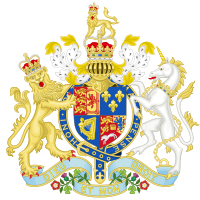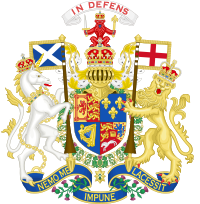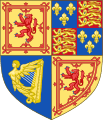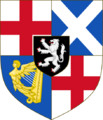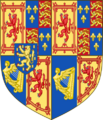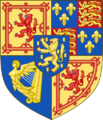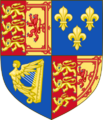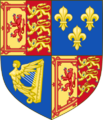Coat of arms of Great Britain facts for kids
The Royal coat of arms of Great Britain was a special symbol. It showed the power of the king or queen in the Kingdom of Great Britain. This kingdom existed from 1707 to 1801.
The Kingdom of Great Britain started on May 1, 1707. This happened when the kingdom of Scotland and the kingdom of England (which included Wales) joined together. They signed a special agreement called the Treaty of Union in 1706. This agreement created one big kingdom. It covered the whole island of Great Britain and its nearby islands. But Ireland stayed a separate country under the new British crown.
On January 1, 1801, the royal arms of Great Britain changed. They became the royal arms of the United Kingdom of Great Britain and Ireland. This happened when Great Britain joined with Ireland. This union was made by the Acts of Union of 1800. It followed a big uprising in Ireland in 1798.
Royal Symbols Through Time
Royal coats of arms are like special badges. They show who is in charge and what lands they rule. The design often changes when new kings or queens take over. It also changes when countries join together.
Before Great Britain was formed, England, Scotland, and Ireland had their own kings and queens. But in 1603, something big happened. James VI, King of Scots, also became King of England and Ireland. This was called the Union of the Crowns. It meant one person ruled all three kingdoms.
When James became king, he combined the royal symbols.
- The arms of England and Scotland were put together.
- The Royal Coat of Arms of Ireland was also added.
James VI & I used a slightly different version in Scotland. In that version, the Scottish symbols were shown first. This tradition continued with all future British kings and queens.
Changes During the Commonwealth (1649-1660)
There was a time when England didn't have a king. This was called the Commonwealth of England. It lasted from 1649 to 1660. During this time, the royal arms changed a lot.
- From 1649 to 1654, new arms were used. They showed England's symbols.
- In 1654, Scotland and Ireland were added to the Commonwealth. So, the Saint Andrew's Cross (for Scotland) was added to the arms.
- From 1655 to 1659, the arms changed again. They included the personal symbols of Oliver Cromwell. He was the leader of the Commonwealth. This version also had a lion and a red dragon as supporters. The Scottish unicorn was removed. The motto was "peace is obtained through war."
- In 1659, the older Commonwealth arms were brought back.
Kings Return (1660-1707)
In 1660, the monarchy was brought back. This was called the Restoration. Charles II became king. He brought back the royal arms that were used before the Commonwealth.
Later, King James II & VII became king. But he was later replaced by his daughter Mary and her husband, William, Prince of Orange. They ruled together.
- From 1689 to 1694, William and Mary combined their symbols. William's arms included a special shield for his family, the House of Orange-Nassau.
- After Mary died in 1694, William ruled alone. He used only his own arms until 1702.
Then, Anne became queen in 1702. She was James II's daughter and Mary's sister. She brought back the royal arms that were used in 1603.
The Royal Arms of Great Britain (1707-1801)
The biggest change happened in 1707. The Acts of Union 1707 officially created the Kingdom of Great Britain. This meant England and Scotland were now one country.
- 1707–1714: The new royal arms of Great Britain were created.
- The symbols of England and Scotland were combined. They were placed in the first and fourth sections of the shield.
- The symbols of France were in the second section. This was a historical claim.
- The harp of Ireland was in the third section.
- 1714–1800: After Queen Anne died, George I became king. He was also the Elector of Hanover. This was a German territory.
- Because of this, the fourth section of the arms changed. It now showed symbols for Hanover. This included symbols for Brunswick and Lüneburg. It also had a crown for his role in the Holy Roman Empire.
These royal arms were used until 1801. That's when Great Britain joined with Ireland to form the United Kingdom.
Images for kids


